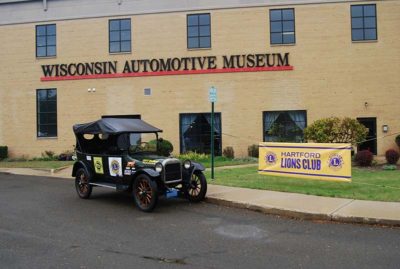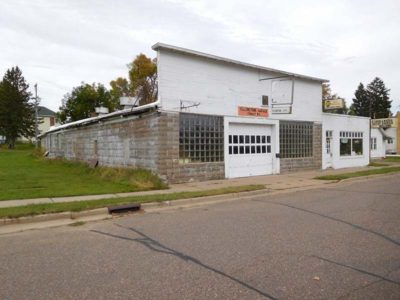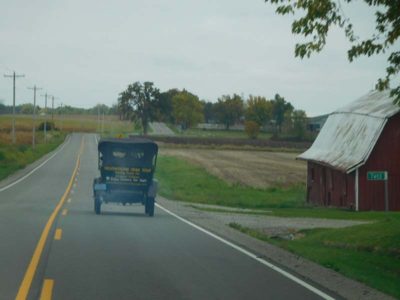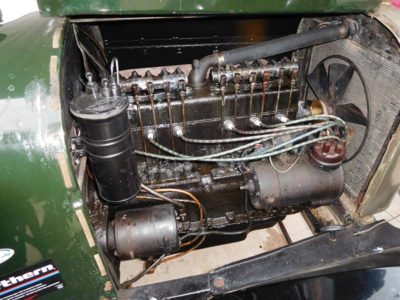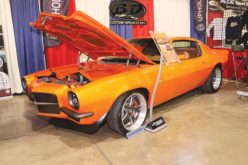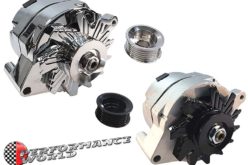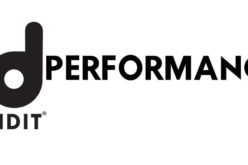Century for Sight Auto Tour Raises Money for Blind Kids
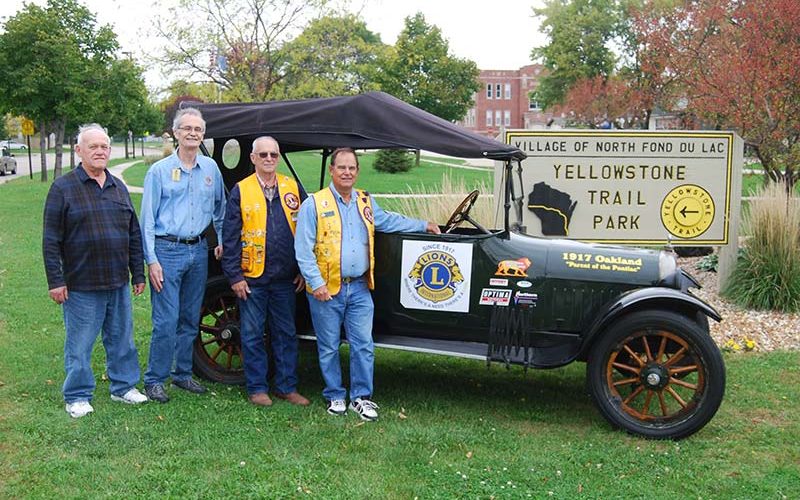
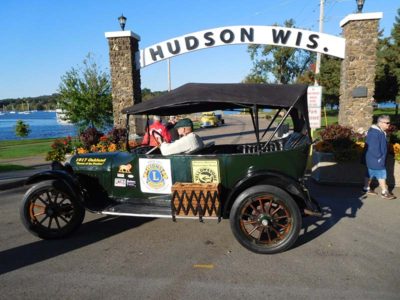
In 1912, there were 356,000 cars sold in the United States. By 1915, that annual sales figure would leap to a million cars. Acceptance of the automobile as a means of travel created a demand for better roads and the idea for The Yellowstone Trail was to create a “good road from Plymouth Rock to Puget Sound.” The first sections of the trail were created in 1912. In 1913, an Oakland automobile blazed the first section of the trail from Minnesota to Yellowstone Park. It was driven by Michael J. Dowling, a triple amputee who refused to let his disability slow him down and who always did what he set out to do.
In 2017, David Sarna set out to drive my 1917 Oakland over the 409-mile section of The Yellowstone Trail in Wisconsin. The 7-day tour started in Hudson, Wisconsin (near Minneapolis) and headed east to Waupaca, Wis. From there, Sarna followed the original trail as closely as possible from Waupaca, through Oshkosh, Fond du Lac and Milwaukee, to its final Wisconsin destination in Kenosha. Like Michael J. Dowling, Dave Sarna refused to give up when the going got tough (or even when it got very tough.)
As a Pontiac collector and historian, the author had always wanted to own an Oakland, the parent make of Pontiac from 1908-1931. In the fall of 2015, he was able to buy an old building that had been an Oakland dealership in 1917. The building had also been a Yellowstone Garage—a recommended stopping place for service work on cars travelling the trail. A month or so later, his son found him a 1917 Oakland Model 34 (a.k.a. “Sensible Six” touring car) for sale at a very reasonable price. He bought it with the intention of pushing it into the old Oakland showroom to use as a static display.
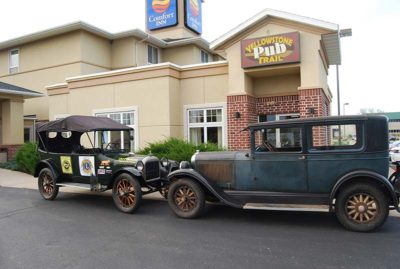
“It’s a natural,” said Dave, “We’ll drive the Oakland across The Yellowstone Trail in Wisconsin to raise money for the Lions Camp for Blind and Disabled Children. People can just donate money or they can pledge so much for every mile we cover.” Dave took his idea to the Manawa Lions and they liked it. The Lions said they would provide a small amount for expenses and arrange stops hosted by Lions Clubs in towns along the trail for lunch and dinner. We selected “Century for Sight” as the theme for the tour and set up a CFS Facebook page where people could get information and download donation forms.
Dave – a retired auto technology instructor at Fox Valley Technical College (www.FVTC.org) – said he would prepare the car for the trip after he got two other “little” things out of the way. The first was an almost-all-summer church mission to Ireland where he loaded ships taking food to Africa. When he got back in July, he immediately started working on our Bonneville racing car—a big-block-Chevy-powered Pontiac Trans Am. In early September, he took that car to the “World of Speed” event at Bonneville Speedway and realized his dream of going 200 mph there. He actually averaged 206 mph.
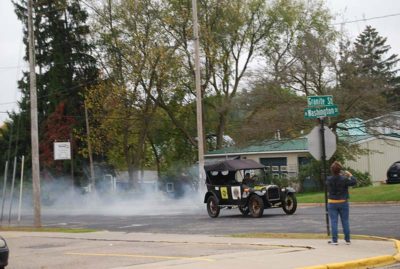
When Dave first got back he thought the engine noise was a spark knock and he figured out the firing order from the valves (we have an owner’s manual, but it does not give firing order, spark gap or oil capacity.) The wires had been hooked up wrong, but after a while, Dave realized the engine still knocked too much. The clutch was also acting funny and the rear axle positioning rivets were loose and had to be welded. The water pump and the carburetor were also leaking and the two-wheel brakes needed adjustment.
The Century for Sight Tour was scheduled for Monday Oct. 9 through Saturday Oct. 14. We would trailer the car to Hudson—a five-hour trip–on Sunday Oct. 8. The week before the trip, Dave took the pan off, and checked all the rod bearings. We discovered the Oakland has insert bearings and that the pistons could be removed from under the car. That was a blessing, because no one seems to sell Oakland head gaskets.
All the rods were dropped, cleaned up and checked for clearance. Oakland used shims to set bearing clearances. Some of the old shims were worn out, so the clearances were loose on several cylinders. We had to make new shims. Three of the pins and bushings were worn, so we had Metal Crafters make us new ones. Joe Thorn, who owns the company, is a Model T and Model A Ford buff, so he rushed the machine work through. By Friday Oct. 7, the car was buttoned up and running again. All seemed in readiness.
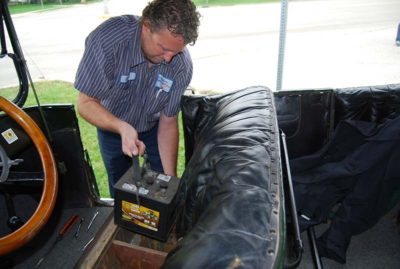
As stated earlier, Dave doesn’t give up easily. “We gotta get this car fixed,” he said. “It’s for the blind kids.” We’d already purchased parts from two men in Pennsylvania who seem to be the only suppliers of Oakland parts in the world. Wayne Koffel restores Oaklands. Andy Wise (www.wiseandysgarage.com) specializes in restoring pre-1950 cars and also re-straps shock absorbers and relines cone clutches with Kevlar. The Oakland has a cone clutch so Andy was our only hope—or was it too late?
Dave called Andy and it turned out that he was at the Antique Automobile Club of America’s Fall National Meet at Hershey, Pa., the biggest old-car show in the world. Wayne Koffel was there, too. They had a used Oakland clutch of the size we needed. We had a local friend named Bob Buchman who was also at the Hershey swap meet. A call to Bob affirmed that he would pick up the clutch and bring it home on Saturday. We picked it up and rushed it to Ron’s Automotive in Manawa, where we installed it on Sunday. We also adjusted the universal joints and lined up the driveshaft more correctly.
After we finished the work (and a few steaks and beers) Dave took the car for a four-mile test run and it came back steaming. Metal Crafters had tried to rebuild the Oakland’s unusual water pump, but they could not press the old shaft out without breaking the housing. Rather than do that, they dressed the section of the shaft that was showing and repacked the pump housing with packing material. It was flowing coolant, but it was leaking a bit. We removed a 1917 license plate that was hanging in front of the radiator, straightened some of the fins and changed the coolant mixture slightly. Then, we put the car on my trailer, strapped it down and took off for Hudson around 4 pm.

Our dinner stop was the Classic Garage in Eau Claire, Wis., an old Texaco station converted to a restaurant by Cadillac collector Rick Payton. With the car on the trailer, we arrived early and went to Eau Claire British Cars where Steve Rindt let us work near his shop. The pan came off again and it was covered with bearing material. The Number 3 rod bearing was completely gone! A few others were loose. Dave put in a call to Andy Wise and found out that new bearings were “unobtanium.” Andy did, however, have four good used bearings and he agreed to ship then to Dave’s wife Debbie by two-day mail.
A large crowd including a TV reporter met us in Eau Claire. We off loaded the Oakland for photos and then loaded it again. Rick Payton said we could keep the car indoors on the trailer at his restoration shop in Chippewa Falls. The next morning, we went there and Dave started working on the bottom end of the engine again. His plan was to work on the rods one by one as we moved along until we got to my Yellowstone Garage at the Waupaca stop. Bob Buchman would meet us there and Debbie would bring the bearing. Bob Hansen, who works for me, and Bob Hanson who was doing coverage of the trip for Waupaca radio station WPAK 106.9 FM would also help with the repairs.
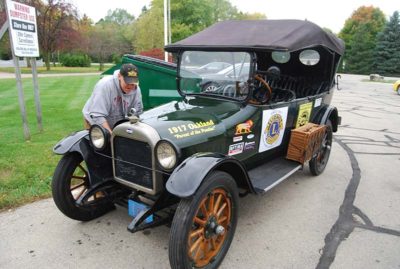
We wound up visiting Plymouth fan Al Breu to use the lift in his home shop and Dave got a few more rods shimmed. Then, we reloaded the car and went to lunch with the Marshfield Lions. After that, we headed to the Comfort Inn at Plover, Wis., where they have a Yellowstone Pub with memorabilia from the trail. John Gehrke of nearby Stevens Point came to see us with his unrestored 1928 Oakland.
The next day was fix-the-car-day. We went to Waupaca where Debbie Sarna brought the parts from Andy Wise and the “three Bobs” were standing by to help Dave finish the engine. There was also a Lions Club lunch at the shop and by coincidence a hot rod club was visiting a collection nearby and stopped at my shop, too. On top of all this, Barney Gaylord of Chicago, who calls himself the MGA Guru, showed up driving his quarter-million-mile MG. Things were really crazy for a while, but the engine got fixed.

The next say we drove the Oakland to North Fond du Lac, where there is a Yellowstone Trail Park and another Yellowstone Garage that Northern Battery Company uses as a warehouse. We picked up a new 6-volt battery and continued out of Fond du Lac, using backroads to drive to Hartford, where our Lions Club dinner stop was at the Wisconsin Automotive Museum. We overnighted in Hartford, then continued the next day through the Milwaukee area and on to our final stop at Gateway Classics in Kenosha.
As you can see, the tour was a challenge, but in the spirit of Michael J. Dowling, we carried on through thick and thin to achieve our goal. Initial feedback tells us that we have brought in over $7,000 in donations for the Lions camp. Hopefully that number will go up as more people hear about the Century for Sight tour and more donations roll in.




